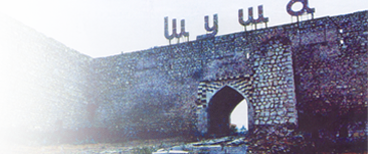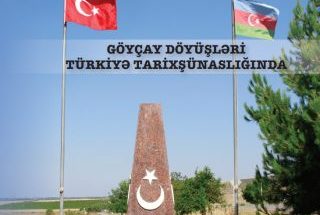 Lithuanian military journalist Richard Lapaytis spoke in an interview with Day.Az.
Lithuanian military journalist Richard Lapaytis spoke in an interview with Day.Az.
Richardas Lapaytis is one of the few Baltic correspondents who is aware of the core of the Armenia-Azerbaijan conflict and truth about the Karabakh war by not just hearsay or stories by other people. In 1992-1993 he repeatedly traveled to Azerbaijan, visited the contact line, was an eyewitness to the bloody events of the war (in Lachin, Nakhchivan, Aghdam, etc.) and took photos of tragic consequences of the Khojaly massacre. This interview was made with the assistance of the Community of Azerbaijanis in Lithuania and Congress of Azerbaijanis in Baltic.
Day.Az: First of all, I want to ask you how you happened to visit Nagorno-Karabakh? Why did you go to the war zone? What specifically you were interested in about this conflict?
Richardas Lapaytis: This interest is likely accidental. I did not go to Nagorno-Karabakh on purpose. At that time, I just was travelled and shot photos and wrote down my impressions in a notebook. I traveled as a tourist seeking opportunities to see more. I traveled not as a journalist.
But so happened that my way passed through the mountains, I loved the Caucasus and shot a lot of photos. However, first of all, I arrived in Armenia where I had to live for long. So, I saw the two conflicting sides with my own eyes. After a relatively long stay in Armenia, I went to Azerbaijan.
This step took more courage and determination, because in Armenia I was told that allegedly presence in Muslim Azerbaijan is dangerous for a Christian. I was forced the opinion that Azerbaijanis in the best case will not take me in their community but at worst – kill me and torture. I admit that it was terrifying to go to Azerbaijan at that time.
Q: And when did you arrive in Azerbaijan?
A: It happened in February 1992. I happened to be in continuous round of military conflict. My arrival coincided with the Khojaly tragedy. First, I stopped in the town of Agdam where many dead bodies of Azerbaijanis were brought to. Ther were wounded, tortured and plundered. Among the dead were not only soldiers but also women, children and the elderly. The bodies were piled up in Agdam mosque for some time.
At that time, when I lived in Aghdam, the town was under constant fire from the Armenian side. There was no light and no water in the hotel where I stayed. Its upper floors were destroyed by bombing. Once, when I was very thirsty, I took a vase of flowers from the stand and drank the accumulated drop of water. But the worst for me were not the everyday difficulties that I encountered at every step, but what I saw with my own eyes. I was prepared neither psychologically or morally for these scenes.
Q: Can you openly state that the bodies of Azerbaijanis piled up in the Agdam mosque has visible signs of torture? Did you take picture of these bodies? Do you keep those pictures? Who tortured them?
A: Yes. Bodies of Azerbaijanis had the most obvious signs of torture. Undoubtedly, I saved these pictures and published many times. At the sight of such a brutal picture, I felt a terrible shock. At that time a view was spreading in Lithuania that they were Azerbaijanis who brutally treated prisoners of war and civilians.
I saw a completely different picture. I have collected dozens of concrete evidence that ethnic cleansing and torture was not carried out by Azerbaijanis, but by Armenians. It was not easy, simple and safe to collect evidence of crimes against humanity, but over time this goal was for me the main occupation.
Q: What political, economic and cultural situation Azerbaijan faces at that time?
A: Azerbaijan was weak both economically and militarily. I had no political friends. Nobody wanted to quarrel with Russia. Especially Europe did not want to quarrel with Russia over Muslim Azerbaijan. The sympathies of many for some reason tilted toward Armenians. Azerbaijani soldiers at that time were young, poorly trained, they did not have enough weapons, ammunition and medical supplies. I saw how two Azerbaijani soldiers shared one Kalashnikov gun. There were not enough bullets and enough warm clothes. Winter was cold and severe.
Azerbaijan was absolutely not ready for the war. Azerbaijanis could not understand how can they could be so clearly and cruelly hurt, according to the popular expression, in broad daylight? They did not understand how hundreds of thousands of people can be evicted from their homes in the late twentieth century? They indeed did not understand what wrong they did to Armenians.
Q: Here once you mentioned that Azerbaijanis are not warlike people …
A: In Lithuania, and not only in Lithuania some say Azerbaijani soldiers are sadists. They say they cut off head, ears and so on. For two years I spent in Azerbaijan I have not seen a single case of cruelty by Azerbaijanis. I did not witness such facts in 1992-1994. I saw the opposite picture – tormented Azerbaijani men, children, old people, women.
Q: You could more specifically describe how Azerbaijanis were tortured?
A: This topic is too hard for me. I do not want to go into details. I can only say that bodies of Azerbaijanis were mutilated in various ways and it was obvious that the majority of people were being tortured alive.
Q: And how civilians in Nagorno-Karabakh were treated during the conflict?
A: This is a very important question. There were no safe corridors for Azerbaijani citizens to leave during the Nagorno-Karabakh conflict. Caravans of retreating women, children and elderly people were persecuted. It is difficult to say why they treated them this way.
Apparently, there were nationalist organizations in Armenia who were generously funded and dreamed of creating a Greater Armenia. These organizations at all costs needed to acquire fertile Nagorno-Karabakh and it required much blood and terror. Members of those organizations even killing their Armenians who refused to shoot in the direction of Azerbaijan. There were such Armenians. That is, the war was not supported by entire Armenia. But I witnessed how a military helicopter piloted by Russian military mercenaries opened fire on a caravan of Azerbaijani civilians trying to flee a war zone.
Q: Did you witness similar tragedies in different towns of Azerbaijan?
A: Khojaly is just one of the cases. Azerbaijanis were killed in other towns as well. For example, in Agdam, Shusha. First there were long and massive bombardment and then survivors were either shot or taken prisoners.
It was the same with Khojaly. Just a few of the Azerbaijani military men armed with assault rifles were in this small town. All other Azerbaijanis had only shotguns. I witnessed this massacre with my own eyes. Together with Azerbaijan military men and journalists we sent bodies of six children with obvious signs of torture by helicopter with great difficulty. My descriptions and my pictures were sent to Lithuania, appeared in some Lithuanian newspapers and I sent my texts to West.
A terrible political scandal erupted soon. Then there was talk that Russian military men and Armenian nationalists will not forgive us for these publications. We heard rumors that even prize was promised for our heads. Some journalists were actually killed by snipers. I do not know of what nationality these snipers were.
However, my good friend journalist Chingiz Mustafayev was killed by a sniper. I do not remember the names of other slain journalists. However, Chingiz died of centrifugal bullets banned by international convention. These bullets, for example, hit a leg and go out through head. In short, it mutilates the whole body. Even the slightest injury in this case is fatal.
I especially remember the tragedy of one of Azerbaijani villages. It was defended by local teachers and students. They defended it courageously, relentlessly, although most of arms were only hunting rifles. Armenians faced great difficulty to take the village and they resorted to deceit. They dressed in the Azerbaijani army uniform and easily entered the village. It was too late when Azerbaijanis guessed deception. To my knowledge, all teachers and students of the school were killed.
Q: You are said to witness even use of chemical weapons in the Nagorno-Karabakh conflict…
A: Yes, it was me who conveyed this information to whole world. This weapon was used in the territory of the Nakhchivan Republic. The use of mustard gas was not a mass phenomenon. However, some Azerbaijani soldiers have died in that years rather strange death. A strange rash and redness were discovered in their bodies. I showed copies of examinations to the Lithuanian Ministry of Health where they officially declared: such a death occurs as a result of mustard gas poisoning. And mustard gas is a chemical weapon the use of which is prohibited by all international conventions.
Q: Have you been accused of being bribed by Azerbaijanis and that you are writing in a biased way and that you’re lying?
A: That period was very difficult. Some of my publications appeared in the then newspapers ‘Nemunas’, ‘Svyturys’, ‘Republic’ and ‘Lietuvos Ryta’. I even spoke at a press conference.
After my articles were published some editors were put a lot of pressure not to publish my them any longer. Even an Armenian member of parliament arrived in Vilnius in order to find out why the Lithuanian press supported Azerbaijan, but not Armenia.
I should be frank. Some editors when I asked for my royalties said they no longer will publish my articles, because the delegation of strange people threatened them almost openly. One of the editors, his name is Stanislaus Balciunas, said even the following: “You are very young, but you will not live long if you continue to behave this way.”
Poetess Marita Kontrimayte was one of those who strongly criticized me. Wherever my articles or interviews were published, Kontrimayte soon appeared. She tried to somehow belittle and otherwise deny my information and she even claimed that I an impostor and that I have never been in Nagorno-Karabakh and not able to understand the real situation.
day.az



